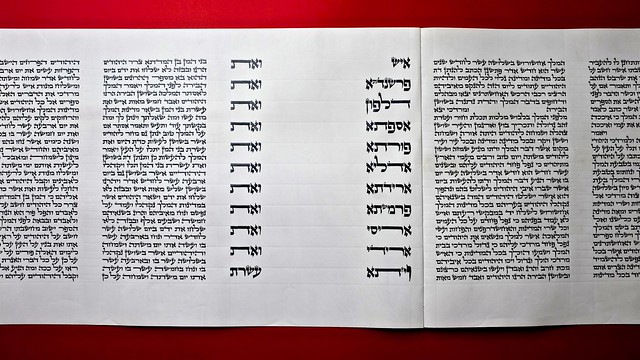According to the masora, certain instances of specific letters in Tanach should be written larger or smaller than the rest of the text.1 Some communities have different traditions regarding which letters should be larger or smaller. As with other matters of masora, each community should follow its own traditions. A STAM item that does not have large and small letters according to the tradition of the community is not pasul, but it should be corrected if possible.2
Letters that are not included in the masoretic lists of large and small letters should not be arbitrarily written larger or smaller. In most STAM items this is usually not an issue, but there are two situations in megilas Ester where it becomes relevant.
“Hints” to G‑d’s Name
Even though the text of megilas Ester does not explicitly mention G‑d by name,3 there are many “hints” in the story to the Divine presence. Among the hints mentioned in the commentaries are several four-word phrases in which the initial letters or final letters spell out G‑d’s name. For example:
(5:4) יבוא המלך והמן היום
(7:7) כי כלתה אליו הרעה
In some megilos, these hints are accentuated, with the relevant letters written noticeably larger than the surrounding text.4

There are instances of this non-masoretic visual emphasis in megilos from many different communities. The practice is old – going back at least several hundred years – but it does not appear to be ancient, and was never widely adopted. It is discouraged by the poskim, but a megila written in this way is still kosher and can be used lechatchila.
The Sons of Haman
A more common example of non-masoretic large letters appears towards the end of megilas Ester (9:7–9), where there is a stacked shira listing the names of the sons of Haman. According to some opinions, this shira – which only takes up eleven lines – should fill the entire height of the column. If the layout of the megila is more than eleven lines tall, many poskim advocate enlarging all of the text of these eleven lines to fill the space.
These poskim maintain that the enlarged letters in this case have a different status than those that hint to G‑d’s name. Their position is based on the assumption that each column stands as a distinct unit. Since the entire column of aseres binei Haman is the same size, it does not conflict with the masora of large and small letters.
note: The list of Haman’s sons contains several masoretic large and small letters. When aseres binei Haman is written larger than the rest of the text in the megila, these masoretic large and small letters are also enlarged proportionally.
Most megilos in the market today follow this opinion and have the eleven lines of aseres binei Haman written large enough to fill the full height of the column.
-= 8 =-
-
For a basic introduction to large and small letters, see STAM 101: Large & Small Letters. ↩
-
This is true whether it follows the tradition of a different community, or does not follow any accepted tradition. ↩
-
There are only two books in Tanach that do not contain the name of G‑d: Ester and Shir Hashirim. ↩
-
Another possible hint to G‑d’s presence in the megila is the repeated use of the word “hamelech”. There is a common practice to emphasize this hint by arranging the layout of the megila so that most of the columns start with the word “hamelech”. See STAM 101: Hamelech for more info. ↩


